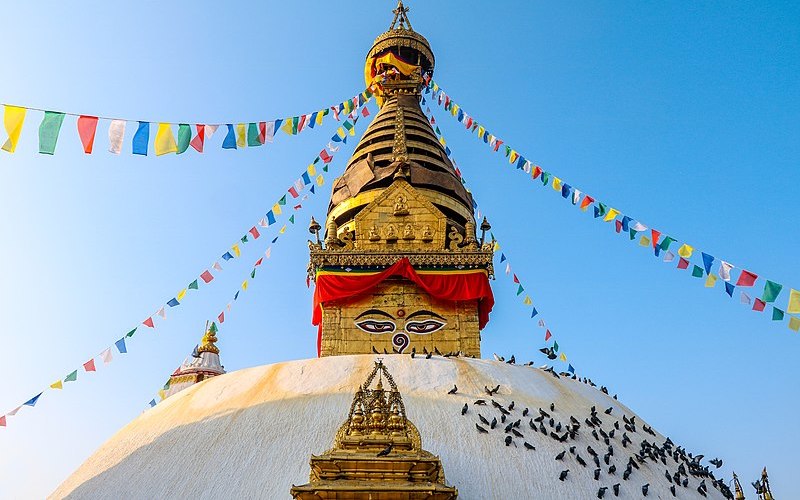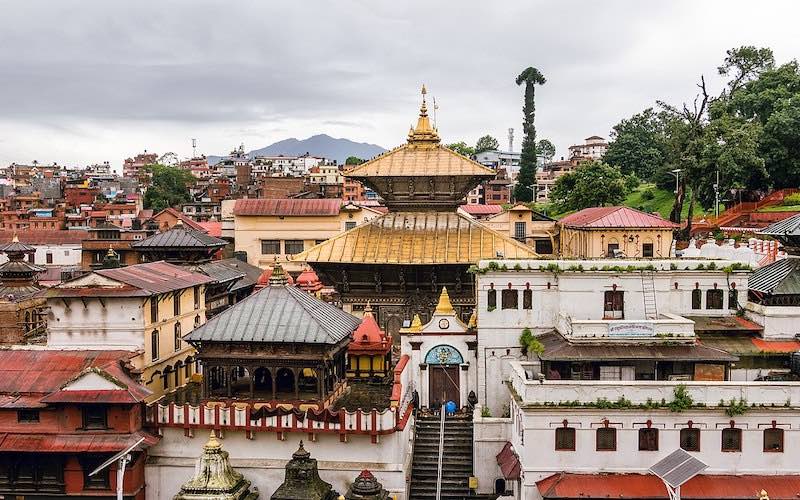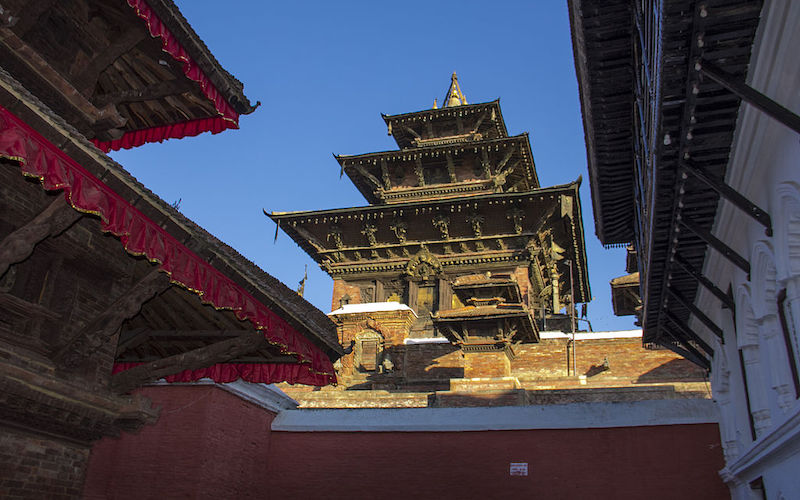If you are looking for an affordable destination for spirituality that is a good alternative to India, then why not try Nepal? Travellers flock from all corners of the world to experience the diverse temples in Kathmandu. You will find both Hindu and Buddhist stupas and monasteries in Nepal’s capital city, often know as Kantipur.
How long should you stay in Kathmandu?
Kathmandu lies in a hilly region near the confluence of the Baghmati and Vishnumati rivers, over 4000 feet above sea level. Most travellers will fly into Tribhuvan International Airport and spend between 3-5 days in Kathmandu. However, I’d recommend staying longer if you can. Nepal is one of the cheapest places to travel in Asia so it’s affordable to spend time there.
What to do in Kathmandu?
Kathmandu is full of Ashrams for meditation and yoga schools, and so it is an excellent place for spirituality and fitness for both the body and mind. If you are interested in religion like I am, then the temples in Kathmandu are phenomenal. You can then follow up your templeseeking with a few days or even weeks worth of trekking. Remember to always go with a reputable guide – I recommend the Nepal Hiking Team.
The Most Amazing Temples in Kathmandu
But now, let’s take a look at the most amazing temples in Kathmandu. The most famous are the Boudhanath Stupa, Swayambhunath Temple and Pashupatinath Temple. If you are pushed for time, it may be more efficient to go to visit these with a guide. Both Viator Travel and Get Your Guide offer Kathmandu temple tours.
Swayambhunath Temple
The Swayambhunath Temple is the white domed temple surrounded by colourful flags that is often the most instantly recognisable image of Kathmandu. It’s a Buddhist temple that is often referred to informally as the Monkey Temple (expect to see rhesus monkeys in droves!). The name of the temple in Tibetan translates to ‘Sublime trees’ because of the variety of so many different trees in the foothills.

The Swayambhunath Temple is the highest point of Kathmandu valley and it is possible to see the 360-degree view of the Kathmandu Valley from the top. It’s not difficult to see why tourists and travellers flock to this temple – it’s worth it for the views from the top alone.
But what about he temple’s religious and historical significance? The Swayambhunath Temple is the oldest of its type in the whole of Nepal and it was built by King Manadeva in approximately 460AD. By the 13th century, it had become an important centre of Buddhism and a popular destination for Buddhist pilgrimage.
Boudhanath Stupa
Boudhanath Stupa is the largest Buddhist Stupa in Nepal and the third-largest in the world. It’s also home to the biggest Tibetan Buddhist community outside of Tibet. Historically, Boudhanath Stupa used to be an ancient resting point for the Tibetan merchants en route from Nepal and India, where they would take time out and perform their holy prayers.
Pashupatinath Temple
Pashupatinath Temple is a Hindu temple that is one of the most interesting and beautiful places to visit in Kathmandu. It is a UNESCO World Heritage Site located on the banks of the river Bagmati. Evidence suggests that the temple dates back to the 4th century, although the main temple that currently stands was built in the 17th century.

Pashupatinath Temple is named after Pashupatinath – an incarnation of Shiva – the protector of animals. The temple itself is a cubic pagoda style temple with the four main doors lined with silver and the two storey main roof is made from pure copper and gold.
Pashupatinath Temple is a place of pilgrimage during Maha Shivratri, the honourary festival of Shiva, the Hindu God of death and destruction. Although the God of death, Shiva is an important force in the balance of the universe. This special night in March is said to be the night where Shiva performs the sacred dance called the Tandava.
Kopan Monastery
On a small mountain top on the outskirts of Kathmandu is Kopan Monastery, a Mahayana Buddhist monastery that was dedicated to people wanting to follow in the footsteps of the Buddha. 370 monks still live there and temporary visitors are also welcomed. Plan to spend at least 2-3 hours at Kopan Monastery exploring, meditating and learning about Buddhism. The monastery also has a library, shop, cafe and gardens.
Taleju Temple
Taleju Temple is a Hindu temple dedicated to Taleju Bhawani, the royal goddess of the Nepal’s Malla dynasty. The temple was built in 1564 and it is located in the famous Durbar Square (a UNESCO World Heritage Site) next to the Hanuman Dhoka Palace Museum.

There are many legends surrounding the importance of the temple including one that proclaims that Taleju Bhawani made a special appearance at the temple’s dedication ceremony where she came disguised as a Bee! The temple escaped the 2015 earthquake with very little damage, also allegedly due to Taleju Bhawani’s protection.
The four main gates to the temple are protected by lions. Inside the temple there are statues depicting the ten-armed goddess along with shrines to both Taleju Bhawani and Kumari (Nepal’s Living Goddess). Kumari is said to be the living incarnation of the Goddess Taleju. (https://english.onlinekhabar.com/taleju-bhawani-in-kathmandu-the-story-of-a-king-and-his-living-goddess.html)
Budhanilkantha Temple
Outside of the city to North you will find the Budhanilkantha Temple which is also known as the temple of the reclining Vishnu. The Vishnu statue is over 1000 years old and carved in a single piece of stone. The Vishnu statue lies in a sacred pool. Thousands of pilgrims visit Kathmandu to attend the Haribondhini Ekadashi Mela on the 11th day of Hindu month of Kartik (October / November) and celebrate the awakening on Lord Vishnu from a very long sleep.
Other Temples Located just Outside Kathmandu
Dakshinkali Temple
The Dakshinkali Temple is dedicated to the Hindu Goddess Kali – Hindu goddess of death, time, and doomsday. She is also a symbol of fertility and motherly love. It is located about 22 km to the South West of Kathmandu, and will take approximately 50 minutes drive. Sacrifices are often made in this temple including cockrels and un-castrated goats!
Nayatapola Temple Bhaktapur
Although not necessarily in Kathmandu itself, the Nayatapola Temple here because it’s less than 30 minutes drive from the centre. It is a 5 roofed Pagoda style temple in Bhaktapur. It is embellished with characteristic stone, metal and wood craftsmanship and has withstood 4 major earthquakes. Bhaktapur is the smallest city in Nepal and it’s worth walking around the city to appreciate the examples of Newari Architecture (traditional Newari Nepalese).
If you enjoyed this article you might also like to read about 10 famous Indian temples.
